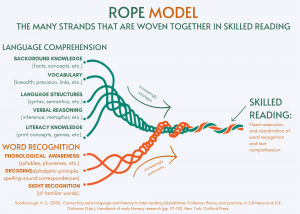There are many different models of reading in English. Each of these has been developed in an attempt to explain the very complex skill of reading.
Earlier this year I was introduced to a model of reading that I am very excited about – The Active View of Reading – and that I want to share with you. But before I do that, I want to talk about some of the different reading models out there, which will help to explain my excitement.
In English speaking countries, most of the models currently in use are based on the Simple View of Reading. The Simple View was developed by Gough and Tunmer (1986) with the aim of ending the “reading wars”. The term “reading wars” is used to describe when educators have opposing points of view about one area of literacy development being more important than another. At the time that Gough and Tunmer published the Simple View of Reading, many literacy experts believed that either language or phonics was the most important area to target for a developing reader – and had heated debates about the topic. However, the truth is that for each reader both factors are equally important, and so the Simple View of Reading was born and is now widely accepted.

Since 1986, a number of other models have been developed, using Simple View of Reading as a basis. Each of these provides elaborations that we have greatly needed for literacy teaching and learning.
In 2000, I was first introduced to Cunningham’s Whole-to-Part (1993) model by the amazing David Koppenhaver and Karen Erickson. In common with most of the other models based on the Simple View of Reading, Cunningham moved away from the term “decoding” and used the phrase “word identification” instead. This is important since fluent readers tend to recognise many words automatically without needing to decode them – although decoding does still occur when required. Cunningham recognises this and refers to both “automatic word identification” and “mediated word identification” in his model.

In 2001, Scarborough published the Reading Rope model which shows “the many strands that are woven into skilled reading”. This is another model that I have used for some time and which I find extremely helpful as it breaks the two main areas of the Simple View of Reading down for us. The Reading Rope model connects early language and literacy to later reading ability and disability and helps us think about all the components that we need to address in our literacy intervention.

One of the important parts of this model is Scarborough’s premise that all the components are interconnected and interdependent. She wants us to understand that if just one strand is weak, it affects the rope (and the reader) as a whole. And, of course, the visual presentation of this model showing all the subskills knitting together to lead to the goal of skilled reading, really helps us to understand this.
More recently, Tunmer & Hoover (2019) provided a model that they called the “Cognitive Foundations Framework”. Once again, this breaks the two main areas from the Simple View of Reading down into a variety of sub-areas. As you can see, there are some similarities and differences between the Rope Model and the Cognitive Foundations of Reading model – and each of them gives us slightly different areas to consider for both our teaching and assessment.

One of the differences between the two models that I want to draw your attention to, is that in The Reading Rope, print concepts falls under Language Comprehension, but in the Cognitive Foundations Framework it falls under Word Recognition. I’ll get back to this further on!
In developing the Cognitive Foundations Framework, the authors acknowledge that it doesn’t deal with factors outside of cognitive ones. This means it doesn’t include psychological and ecological factors. They also make it clear that this is a hierarchical structure. Despite this, they don’t suggest that the “development of the higher-order cognitive elements cannot occur until all of the lower-order elements are fully developed – although it does assume that some level of mastery is needed.” (Tunmer & Hoover (2019).
And then early this year my friend Nick Drover (hi Nick), pointed me towards the Active View of Reading. I got very excited as it offers us a strong progression, still based on the Simple View of Reading, but incorporating additional understandings about reading with comprehension.

There are so many things I am excited about with this model!
As you can see, it again has different skills listed under the two areas from the Simple View of Reading. Additionally, it has represented those two areas as circles that intersect. The authors have called that intersection “Bridging Processes”. Bridging Processes has given the authors a place to position skills, like print concepts, that often jump from area to area across other models as I mentioned earlier. It also gives them a place to put fluency, which has a huge chunk of research devoted to it, but which often doesn’t appear in other models for a range of reasons.
I am also really excited about the list of skills that fall under Language Comprehension. The authors give us a broad view of language that acknowledges factors like cultural knowledge that aren’t mentioned in other models – but still includes language structure and background knowledge. And they bring in theory of mind – which has a massive impact on comprehension. Hooray!
The Word Recognition section consists of the expected range of skills in this area. But, most importantly, they begin their model by including an extra area that is a critical component for reading with comprehension – active self-regulation.
Active Self-Regulation impacts students I work with every week. Not just in reading, of course, but across their day. If you are reading this blog, you are probably working on literacy with one or more students who cannot rely on speech alone to be heard and understood and/or who are neurodivergent – and I know this means that you also realise the impact this area has. Having it acknowledged in this model is incredibly important for many students as well as for educators. It is something we need to consider at all times – and every day we need to support students to learn to actively self-regulate by starting with co-regulation strategies and moving towards self-regulation where possible.
And then the authors delighted me even more, by publishing an evaluation of the components of their model and then discussing the implications for social justice. Yay! The diagram below shows the model with the effect sizes for each area.


If you want to read the original article about the Active View of Reading, the article that introduces it is available here.
I hope this model is as exciting to you as it is to me. I’d love to hear what you think of it in the comments.
(And if you would like to read Hoover and Tunmer’s discussion of the Active View, that is also freely available.)
References
Burns, M. K., Duke, N. K., & Cartwright, K. B. (2023). Evaluating components of the active view of reading as intervention targets: Implications for social justice, School Psychology, 38(1), 30–41. https://doi.org/10.1037/spq0000519
Cunningham, J.W. (1993). Whole‐To‐Part Reading Diagnosis, Reading & Writing Quarterly, 9(1), 31-49. DOI: 10.1080/1057356930090103
Duke, N.K., & Cartwright, K.B. (2021). The Science of Reading Progresses: Communicating Advances Beyond the Simple View of Reading. Reading Research Quarterly, 56(1), 25–44. https://doi.org/10.1002/rrq.411
Gough, P. B., & Tunmer, W. E. (1986). Decoding, Reading, and Reading Disability, Remedial and Special Education, 7(1), 6-10. https://doi.org/10.1177/074193258600700104
Hoover, W. A., & Tunmer, W. E. (2022). The Primacy of Science in Communicating Advances in the Science of Reading. Reading Research Quarterly, 57(2), 399–408. https://doi.org/10.1002/rrq.446
Scarborough, H. S. (2001).Connecting early language and literacy to later reading (dis)abilities: Evidence, theory, and practice. In S.B Neuman & D.K. Dickinson (Eds.), Handbook of early literacy research (pp. 97-110). New York: Guilford Press.
Tunmer, W.E. & Hoover, W.A. (2019). The cognitive foundations of learning to read: a framework for preventing and remediating reading difficulties, Australian Journal of Learning Difficulties, 24:1, 75-93, DOI: 10.1080/19404158.2019.1614081


Peta Ryan Key Support Teacher Autism
jane
Victoria
jane
abamb0
jane
Kylie Gough
jane